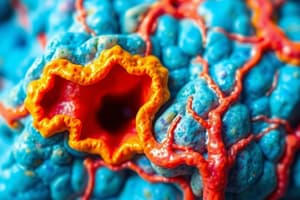Podcast
Questions and Answers
Qual é a principal função do tecido muscular?
Qual é a principal função do tecido muscular?
- Recobrir e proteger órgãos internos
- Gerar tensão e facilitar o movimento (correct)
- Fornecer estrutura e suporte para o corpo
- Transmitir sinais elétricos pelo corpo
Qual é a diferença entre os músculos esqueléticos e os músculos lisos?
Qual é a diferença entre os músculos esqueléticos e os músculos lisos?
- Os músculos esqueléticos são voluntários, enquanto os músculos lisos são involuntários (correct)
- Os músculos esqueléticos são compostos de células não contráteis, enquanto os músculos lisos são compostos de células contráteis
- Os músculos esqueléticos são encontrados apenas no esqueleto, enquanto os músculos lisos estão presentes em todo o corpo
- Os músculos esqueléticos são responsáveis por movimentos conscientes, enquanto os músculos lisos regulam funções como o diâmetro dos vasos sanguíneos
Qual é a principal função do tecido conjuntivo?
Qual é a principal função do tecido conjuntivo?
- Conduzir sinais elétricos pelo corpo
- Fornecer estrutura e suporte para o corpo (correct)
- Gerar tensão e facilitar o movimento
- Recobrir e proteger órgãos internos
Qual é a principal função do tecido nervoso?
Qual é a principal função do tecido nervoso?
Qual é a principal função do tecido epitelial?
Qual é a principal função do tecido epitelial?
Qual é o papel do tecido epitelial no corpo humano?
Qual é o papel do tecido epitelial no corpo humano?
Qual é a função do tecido conjuntivo no organismo?
Qual é a função do tecido conjuntivo no organismo?
O que caracteriza o tecido muscular?
O que caracteriza o tecido muscular?
Qual é a principal função dos tecidos conectivos especializados?
Qual é a principal função dos tecidos conectivos especializados?
Por que os tecidos conectivos variam amplamente em suas propriedades?
Por que os tecidos conectivos variam amplamente em suas propriedades?
Flashcards are hidden until you start studying
Study Notes
The World of Tissues
In the grand tapestry of living organisms, tissues play a crucial role as the basic units of structure and function. They form the foundation for organs, organ systems, and ultimately, life itself. Despite the diversity of cells in our bodies, they can be categorized into four broad groups: epithelial, connective, muscle, and nervous. Let's explore these tissues in detail.
Epithelial Tissue
Epithelial tissue, also known as epithelium, is a sheet-like tissue that covers the exterior surfaces of the body, lines internal cavities and passageways, and forms certain glands. It serves as a barrier between the internal environment of an organism and the outside world, protecting the body from foreign particles and pathogens.
Connective Tissue
As its name suggests, connective tissue is responsible for binding the cells and organs of the body together. It plays a vital role in the protection, support, and integration of all parts of the body. Connective tissues vary widely in their properties, ranging from firm and rubbery in cartilage to rigid and impregnated with hard crystals of inorganic salts in bones. The strength and flexibility of these tissues allow for diverse structures and functions, providing the foundation for organ and physiological functioning.
Specialized Connective Tissue
Within the broader category of connective tissue, there exist specialized varieties designed for specific tasks. One notable example is muscle tissue, which is responsible for movement. It consists of contractile cells that generate tension in response to external stimuli, thus facilitating motion. Another example is nerve tissue, which conducts electrochemical signals between different regions of the body, enabling communication and coordination.
Muscle Tissue
Just as crucial as connective tissue, muscle tissue represents another distinct category. It is made up of contractile cells that respond to stimulus and generate tension, thereby driving the movements we experience every day. Muscle tissue comes in two primary forms: skeletal (voluntary)muscles, which facilitate conscious movement, and smooth muscles, which perform involuntary actions, such as regulating the diameter of blood vessels.
Each of these tissues contributes uniquely to the complexity and functionality of living beings, illustrating the intricate web of connections and interactions that sustain life.
Studying That Suits You
Use AI to generate personalized quizzes and flashcards to suit your learning preferences.




